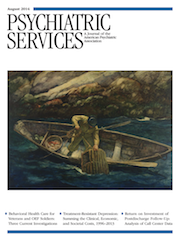Use of Augmentation Agents for Treating Depression: Analysis of a Psychiatric Electronic Medical Record Data Set
Abstract
Objective
This study evaluated the relationship between patient characteristics and augmentation strategies for the treatment of major depressive disorder.
Methods
This retrospective, cross-sectional study used data from a psychiatric electronic medical record database for patients with depression without psychosis or psychotic features who initiated augmentation therapy between January 2001 and June 2011. Medical records were evaluated to identify factors predicting use of specific augmentation agents, and a multivariate logistic regression model was used to assess clinical and demographic predictors of augmentation strategy.
Results
Of 3,209 patients initiating augmentation therapy for depression, 75% received augmentation with an antidepressant combination and 11% received augmentation with second-generation antipsychotics. Baseline clinical severity (Clinical Global Impressions–Severity score) most strongly and consistently predicted augmentation with second-generation antipsychotics.
Conclusions
Treatment of patients in specialty settings with depression was often augmented with an antidepressant combination, whereas those with severe depression had an increased likelihood of augmentation with second-generation antipsychotics.



